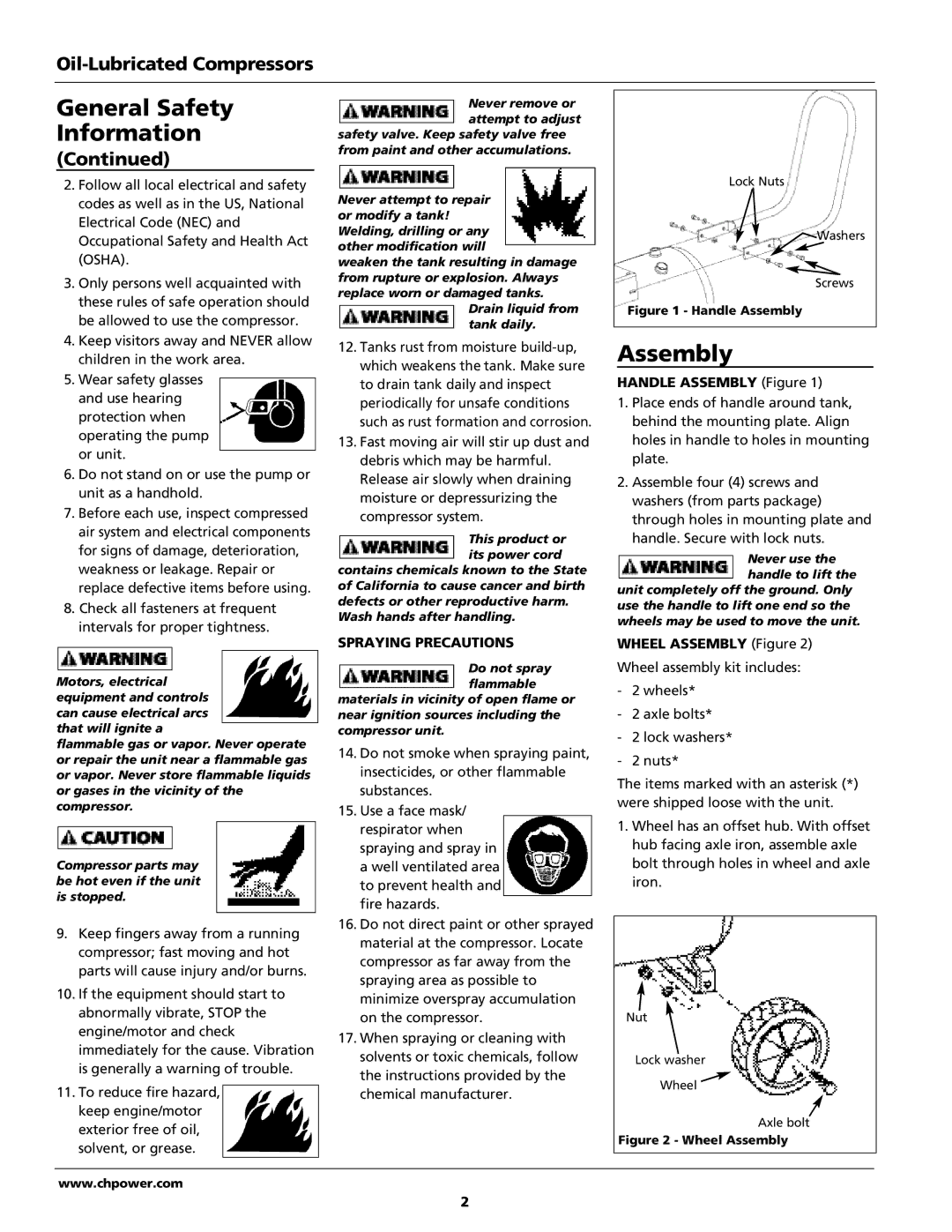
Oil-Lubricated Compressors
General Safety
I n f o rm a t i o n
( C o n t i n u e d )
2 . Follow all local electrical and safety codes as well as in the US, National Electrical Code (NEC) and Occupational Safety and Health Act ( O S H A ) .
3 . Only persons well acquainted with these rules of safe operation should be allowed to use the compressor.
4 . Keep visitors away and NEVER allow children in the work area.
5 . Wear safety glasses and use hearing protection when operating the pump or unit.
6 . Do not stand on or use the pump or unit as a handhold.
7 . Before each use, inspect compressed air system and electrical components for signs of damage, deterioration, weakness or leakage. Repair or replace defective items before using.
8.Check all fasteners at frequent intervals for proper tightness.
Motors, electrical equipment and controls can cause electrical arcs that will ignite a
flammable gas or vapor. Never operate or repair the unit near a flammable gas or vapor. Never store flammable liquids or gases in the vicinity of the
c o m p r e s s o r .
Compressor parts may be hot even if the unit is stopped.
9 . Keep fingers away from a running compressor; fast moving and hot parts will cause injury and/or burns.
1 0 . If the equipment should start to abnormally vibrate, STOP the engine/motor and check immediately for the cause. Vibration is generally a warning of trouble.
1 1 . To reduce fire hazard, keep engine/motor exterior free of oil, solvent, or grease.
Never remove or attempt to adjust
safety valve. Keep safety valve free from paint and other accumulations.
Never attempt to repair or modify a tank! Welding, drilling or any other modification will
weaken the tank resulting in damage from rupture or explosion. Always replace worn or damaged tanks.
Drain liquid from tank daily.
1 2 . Tanks rust from moisture
1 3 . Fast moving air will stir up dust and debris which may be harmful. Release air slowly when draining moisture or depressurizing the compressor system.
This product or its power cord
contains chemicals known to the State of California to cause cancer and birth defects or other reproductive harm.
Wash hands after handling.
SPRAYING PRECAUTIONS
Do not spray f l a m m a b l e
materials in vicinity of open flame or near ignition sources including the compressor unit.
1 4 . Do not smoke when spraying paint, insecticides, or other flammable
s u b s t a n c e s .
1 5 . Use a face mask/ respirator when spraying and spray in a well ventilated area to prevent health and fire hazards.
1 6 . Do not direct paint or other sprayed material at the compressor. Locate compressor as far away from the spraying area as possible to minimize overspray accumulation on the compressor.
1 7 . When spraying or cleaning with solvents or toxic chemicals, follow the instructions provided by the chemical manufacturer.
Lock Nuts
![]() W a s h e r s
W a s h e r s
S c r e w s
Figure 1 - Handle Assembly
A s s e m b l y
HANDLE ASSEMBLY (Figure 1)
1 . Place ends of handle around tank, behind the mounting plate. Align holes in handle to holes in mounting p l a t e .
2 . Assemble four (4) screws and washers (from parts package) through holes in mounting plate and handle. Secure with lock nuts.
Never use the handle to lift the
unit completely off the ground. Only use the handle to lift one end so the wheels may be used to move the unit.
WHEEL ASSEMBLY (Figure 2)
Wheel assembly kit includes:
-2 wheels*
-2 axle bolts*
-2 lock washers*
-2 nuts*
The items marked with an asterisk (*) were shipped loose with the unit.
1 . Wheel has an offset hub. With offset hub facing axle iron, assemble axle bolt through holes in wheel and axle i r o n .
N u t
Lock washer
W h e e l
Axle bolt
Figure 2 - Wheel Assembly
w w w . c h p o w e r . c o m
2
